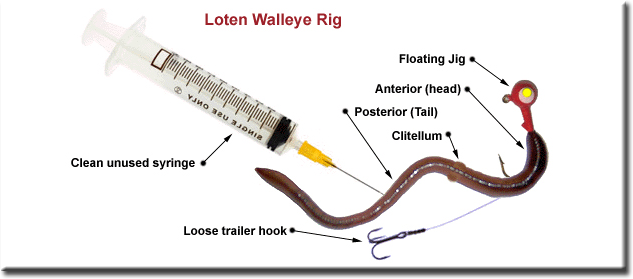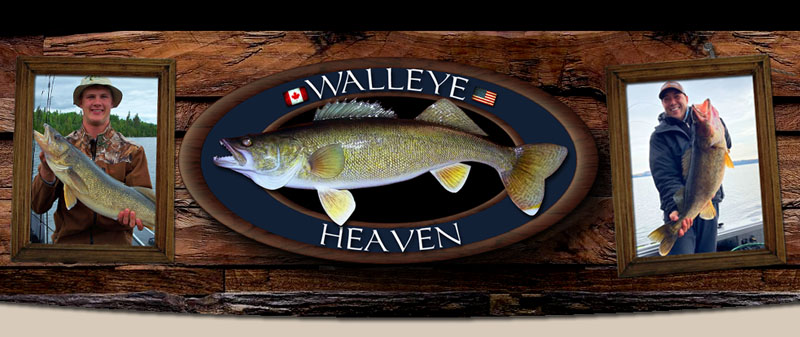Bottom Bouncing Walleye Fishing Rig
My 3-way swivel method is great for fishing for deep walleyes that are over 20 feet deep and it's good for covering ground when the Walleyes are spread out. Sometimes because of sunlight or air pressure the Walleyes slow right down and go deeper in the 15 to 20-foot range. Deeper water tends to be where plant material settles and there is no wave action to clean the rocks so the bottom can be mucky. Because there is a lot less sunlight the weeds may only be a few inches high and in the case the Walleyes are not hiding in weeds but are hugging the tops and looking for bugs and stuff on the bottom.
In this type of scenario jigging with regular jigs is not that effective because your jig gets covered with muck and weeds really fast. Also the Walleyes are less aggressive and tend go after slow moving or stationary baits. When we are faced with this we usually go with a bottom bouncing Walleye rig, which is called a Loten Rig after Greg Loten, a commercial bush pilot who perfected the technique. It's very similar to the traditional Lindy rig but with some refinements, which really do make a difference.
You need a floating jig, a hypodermic needle, a small trailer hook on a 3-inch lead-line, a 1/4 or 1/8 oz slip sinker and a split shot.

First, slide a 1/8 ounce (1/4 if it's windy) slip-sinker down your line and tie on your floating jig. Second, put the trailer hook on your floating jig hook. Then hook your floating jig into the head of the worm but don't go into or past the clitellum or the bottom half of the worm will not hold air. Then take your hypodermic needle and at an elongated angle inject the worm with air. If you just stick the needle in from the side (which my diagram shows incorrectly) the air leaks out and the rig will not be as buoyant. Then place the split-shot sinker between the jig and the slip sinker. If the weeds are 6 inches off the bottom then put the split-shot about 9 inches from the floating jig. If you are drifting fast than you can have two or three feet from the slip sinker to the jig.

Now you drop the rig down to the bottom in the 15 to 25-foot range. I would say the perfect depth is 20-foot for big female Walleyes but every lake is different. We were catching them 30 feel deep on Lady Evelyn Lake. We do very well on most other lakes around 20 feet deep.
You do not want to jig the rig way up like a normal jig or jig it aggressively. Rather you want to drag the jig 6 to 12 inches at a time and do it very slowly. Then let the rig just sit on bottom for a few seconds and then do it again. If you feel resistance stop and see if you can feel the walleye sucking on the worm. If it feels like a Walleye set the hook hard. If you find the rig is staying really clean because the weeds and moss are really short, you can slide the split-shot sinker up towards the rig a bit more so that the floating jig and worm stay closer to the bottom. You want to be as close to the bottom as possible without touching the bottom.
If you are in a rocky area with lots of snags, don't drag the rig horizontally like you would on a flat bottom. Rather slowly jig up and then over and then let the rig site back down on the bottom for a few seconds. The key is to do everything slow. When Walleyes go deep it means there is a reason why they went deep and their feeding patterns get disrupted and they become very lazy.
Most people do not want to admit it but Walleyes spend most of their time bottom feeding. They do go after minnows and leeches but their primary diet in many lakes is anything they can eat off the bottom. So when the Walleyes are deeper and have slowed down, a deep bottom bouncing Walleye rig works wonders.
Dreaded Mayfly Hatch
It's really sad that some people travel a long way from home to go on their dream Walleye fishing trip only to hit the Mayfly hatch and don't know what to do. Luckily it only last a couple of days. When the Walleyes are feeding on Mayflies it is really hard to catch them with traditional fishing methods. Trout and Whitefish wait for the Mayflies to reach the surface. As I said before, Walleyes are bottom feeders and they are right on bottom during the Mayfly hatch picking off the newly hatch larva as they come out of the mud. This is when the Loten Bottom Bouncing Walleye rig comes in really handy and will produce outstanding results.
You can tell what the Walleyes are eating by looking in their stomachs when you clean them and looking at the color of their meat. If they are eating small minnows, leeches, crayfish and bugs, their meat is generally white. If they have been feeding on deeper suspended oily fish like Whitefish, Cisco, Shad or Lake Herring, their meat goes semi-translucent and can taste fishy.
 World Record Walleye (Ice)
Ontario Record Walleye
Walleye Pictures 5 (newest)
Walleye Pictures 4
Walleye Pictures 3
Walleye Pictures 2
Walleye Pictures 1
Anderson's Lodge Photos
Blue Walleye
Walleye Biology
World Record Walleye (Ice)
Ontario Record Walleye
Walleye Pictures 5 (newest)
Walleye Pictures 4
Walleye Pictures 3
Walleye Pictures 2
Walleye Pictures 1
Anderson's Lodge Photos
Blue Walleye
Walleye Biology
 World Record Walleye (Ice)
Ontario Record Walleye
Walleye Pictures 5 (newest)
Walleye Pictures 4
Walleye Pictures 3
Walleye Pictures 2
Walleye Pictures 1
Anderson's Lodge Photos
Blue Walleye
Walleye Biology
World Record Walleye (Ice)
Ontario Record Walleye
Walleye Pictures 5 (newest)
Walleye Pictures 4
Walleye Pictures 3
Walleye Pictures 2
Walleye Pictures 1
Anderson's Lodge Photos
Blue Walleye
Walleye Biology





